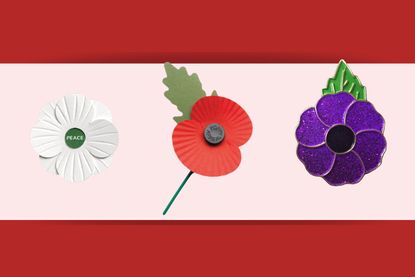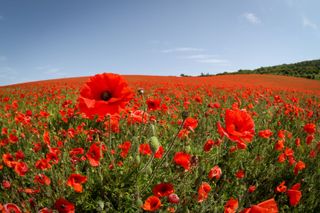Which side do you wear a poppy on and what are different coloured poppies for?
Which side do you wear a poppy on? We answer all your FAQs on the poignant poppy


Remembrance Day 2023 is on the horizon, so many people are wondering which side do you wear a poppy on and what do the different colours of the poppy mean?
Every year, people start wearing a poppy in November, especially leading up to Remembrance Day on 11 November, to honour and remember the millions of people who died in World War I.
The red poppy is a symbol of remembrance, but you may have seen other colours such as black and purple – even white poppies – being worn during this period.
We’ve shared what each colour represents and the tradition for wearing a poppy below.
Which side do you wear a poppy on?
Traditionally, in many countries like the UK and Canada, the red poppy is worn on the left lapel (part of the front of a jacket or coat) or left side of your chest. This is to honour and remember the military personnel who have died in war.
Some people ask, why do females wear poppies on the right? However, in general, men and women tend to wear their poppy on the left, as it’s said to be closer to the heart.
The late Queen Elizabeth II, along with other members of the royal family, would be seen wearing multiple poppies, often referred to as the Five Poppy Tribute. Each poppy typically represents a different branch of the military services: the army, navy, air force, civil defence and women in the services.
GoodtoKnow Newsletter
Parenting advice, hot topics, best buys and family finance tips delivered straight to your inbox.
A post shared by Royal British Legion (@royalbritishlegion)
A photo posted by on
With that being said, the Royal British Legion has publicly shared that “there is no ‘correct’ way” to wear a poppy.
The national network that supports the armed forces added: “It’s a matter of personal choice whether someone chooses to wear a poppy and how they choose to wear it. We simply ask that if you do wear a poppy, you wear it with pride.”
What does the red poppy represent?
As mentioned, the red poppy is a symbol of remembrance and used to honour and commemorate military personnel who have died in war, specifically World War I and subsequent conflicts.
This tradition originated from the famous war poem In Flanders Fields by John McCrae, where the red poppies were the first to grow in the battlefields of Flanders during WW1. The Royal British Legion distributes red poppies as a way to raise funds to support veterans and their families.
You can buy your paper poppy or poppy pin via the Royal British Legion online shop or pick one up in person – with many poppy appeal boxes widely available in supermarkets, cafes and other public places.

What does the purple poppy represent?
Not as widely recognised as the red poppy, the purple poppy is used by some to commemorate and raise awareness about the services and sacrifices made by animals during the war.
It mainly represents animals such as horses and dogs which provided support, transportation and companionship to soldiers, so the purple poppy is a symbol of their service and recognition of their contributions.
What does the black poppy represent?
The black poppy is a symbol to remember and honour the contributions of Black, African and Caribbean military personnel who served in various wars.
It’s a symbol of remembrance for the often overlooked and underappreciated sacrifices and contributions of Black soldiers and service members.
pic.twitter.com/MPAkp8k3GiOctober 21, 2022
The initiative, titled 'Black Poppy Rose,' was launched in 2010 and aims to make the black poppy a world-wide symbol of remembrance, to educate and empower through understanding of historical timelines, and to empower self identity within the Black, African, West Indian, Caribbean, Pacific Island and Indigenous Nations communities.
A statement on the Black Poppy Rose website reads: “A symbol that signifies pride, honour and glory, with the hope that future generations will be inspired by these largely untold historical legacies.”
What happened to the ceramic poppies?
Perhaps more durable than its paper counterparts, ceramic poppies were sold to the public after the Blood Swept Lands and Seas of the Red art installation was displayed at the Tower of London in 2014.
This installation marked the centenary of the outbreak of World War I. It consisted of 888,246 ceramic poppies, each representing a British or Commonwealth military fatality during the war. Each poppy cost £25 and over £15 million was raised and donated to six military service charities.
In 2018, the Tower of London followed up with another centenary display to mark 100 years since the end of WW1 (11 November 1918). The installation saw thousands of flames lit in the moat in memory of the fallen and was carried out by designer Tom Piper and sound artist Mira Calix.
Video of the Week
Check out this adorable moment when Kate Middleton gifted her poppy to a schoolboy last year and Loose Women fans might be wondering why does Charlene White not wear a poppy?

Emily Stedman is the former Features Editor for GoodTo covering all things TV, entertainment, royal, lifestyle, health and wellbeing. Boasting an encyclopaedic knowledge on all things TV, celebrity and royals, career highlights include working at HELLO! Magazine and as a royal researcher to Diana biographer Andrew Morton on his book Meghan: A Hollywood Princess. In her spare time, Emily can be found eating her way around London, swimming at her local Lido or curled up on the sofa binging the next best Netflix show.
- Ellie HutchingsFamily News Editor
- Daniella GrayFamily News & Wellbeing Writer
-
 Compromising may be killing your relationship - here are 5 ways to reach healthy compromises, according to relationship expert
Compromising may be killing your relationship - here are 5 ways to reach healthy compromises, according to relationship expertCompromising isn't always the best way to keep the peace in a relationship
By Charlie Elizabeth Culverhouse Published
-
 Best interactive pets for kids: 15 gift ideas for children of all ages
Best interactive pets for kids: 15 gift ideas for children of all agesFrom puppies to axolotls, take a look at our selection of the best interactive pets you can buy that are sure to be a hit with little animal lovers
By Sarah Handley Published